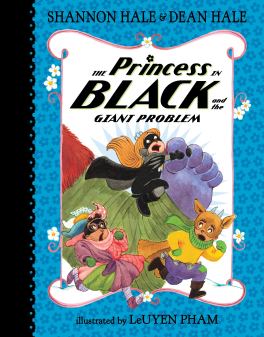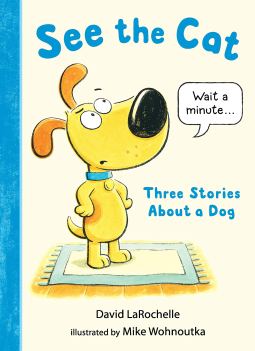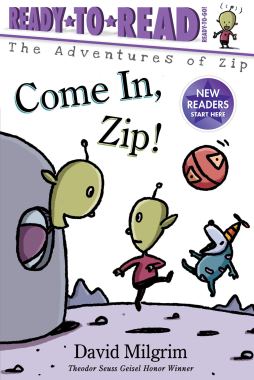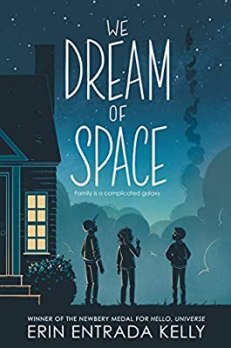Over the past few months, I haven’t done a great job of keeping up with new books other than a few middle grade novels and even fewer YA books. I’ll also probably have a new list of picture books to post sometime between now and the end of the year, when it’ll be time for my Best Books of 2020 list. But for now, here’s a quick list of some early readers, chapter books, and graphic novels that I’ve read and liked within the past couple weeks.
 The Princess in Black and the Giant Problem by Shannon & Dean Hale, illustrated by LeUyen Pham
The Princess in Black and the Giant Problem by Shannon & Dean Hale, illustrated by LeUyen Pham
Chapter book, recommended for grades K-2
In my opinion, the first several books in this series are some of the best books out there for kids at that reading level. Princess Magnolia is in many ways your stereotypical girly-girl princess in a big pink dress, but she has a secret identity. As the Princess in Black, she dons a ninja-like costume and fights monsters. The plentiful, brightly-colored illustrations make these stories feel as fun and easy as picture books, and the large font size and relatively simple sentence structure keep them beginner-friendly. But in actuality, they’re nearly a hundred pages long with multiple paragraphs on most pages. And they contain more “big words” than most books at a similar reading level. So they really pack quite a lot of educational value for a budding reader on top of the genre appeal factors, the likable protagonist, and the humor. Unfortunately, the latest couple books haven’t been quite as good as the earlier ones. There are new hero/princess characters introduced in almost every book, sometimes several of them within the space of a few pages. If I counted correctly, we’re up to 14 now, each with their own sidekick animal. The books simply aren’t long enough to continue including everyone in every book. I still feel that this newest Princess in Black books is among the best new chapter books of the year, but it’s a bit of a disappointment after the earlier, better books in the series.
 Twins by Varian Johnson and Shannon Wright
Twins by Varian Johnson and Shannon Wright
Graphic novel, recommended for grades 4-6
I was intrigued when I heard that Varian Johnson, author of The Parker Inheritance from 2018 and The Great Greene Heist from 2014, was coming out with a graphic novel. For this book, he teamed up with illustrator/cartoonist Shannon Wright. The resulting graphic novel is a fun, quick read about sibling rivalry that will appeal to fans of Raina Telgemeier and Shannon Hale. Protagonists Maureen and Francine Carter are twins who had always been close in elementary school, but now that they’re in middle school, Francine wants to distance herself from her sister. When Maureen and Francine end up running for class president against each other, the rift in their relationship escalates to a full-blown feud. I appreciated this book’s honest depiction of the struggles that twins face when trying to establish their own identities. Since I also had a twin sister myself, I dislike when books or movies give the impression that twins are automatic best friends and that there aren’t any hardships that come along with it. When I finished the book and saw that acknowledgements, I discovered that Varian Johnson also had a twin. His relevant childhood experiences show in the way that he’s able to portray the twin sisters’ pain and insecurities and the resulting animosity between them without portraying either sister as the “bad guy”.
 See the Cat: Three Stories About a Dog by David LaRochelle, illustrated by Mike Wohnoutka
See the Cat: Three Stories About a Dog by David LaRochelle, illustrated by Mike Wohnoutka
Early Reader, recommended for preschoolers and kindergartners
Remember when you were learning how to read and all the “stories” just said things like “see the dog” and “see the dog eat”? I personally wasn’t exposed to Dick and Jane until I was already reading fluently, but I started with the classic reading-lesson book Teach Your Child to Read in 100 Easy Lessons, which still started you off with imperative sentences about seeing animals eating or reading. After all, there’s only so much plot you can put into a story when you’re trying to keep sentences under five words while only using familiar, monosyllabic words. But in this book, LaRochelle finds a way to have some fun with that extremely controlled vocabulary. In the first of the three stories, everything we’re being told to “see” isn’t there in the picture. What cat? What green dress? Poor Max the Dog doesn’t know what the book is talking about. The joke is simple enough that even a child who is still struggling to sound out words will pick up on it. Each of the other two stories has a similar simple joke. There are a few long sentences in there, but an absolute beginner can probably still handle it with an adult’s help.
 Come In, Zip! By David Milgrim
Come In, Zip! By David Milgrim
Early Reader, recommended for preschoolers and kindergartners
This is another great book for kids who are still in the sounding-it-out phase. (Although it’s a rhyming book with a consistent meter that will be lost when read by a beginner) This is actually part of a series, but it functions as a standalone story, too. Zip is a young space alien who would rather play outside than come in for bed. He tries to run away from his mother, and when that doesn’t work, he tries escaping an a car and a jet (presumably imaginary) before his mother eventually succeeds in bringing him in for bed. Despite the sparse text and controlled vocabulary, this book tells a complete story (albeit a story with a very simple plot) and portrays an affectionate mother-child relationship that will appeal to the grownup who is helping the child read the book. This one would function well as a bedtime story.
 Magic Tree House #34: Late Lunch with Llamas by Mary Pope Osbourne
Magic Tree House #34: Late Lunch with Llamas by Mary Pope Osbourne
(This is actually book #62 if the original 28 books and the Merlin Missions are counted as one continuous series)
Chapter book, recommended for grades 2-4
In this latest installment of the popular Magic Tree House series, Jack and Annie travel to the Andes during the time of the Incan Empire. As in many of the other books in the series, they have a note from the sorceress Morgan le Fay that gives them vague hints about their mission. So far, they only know that it has something to do with rescuing a creature and that “old legends” will help them. Soon after arriving, they meet a boy whose beloved llama has just been taken by royal guards from the Secret City. (Jack and Annie later learn that “the Secret City” is Machu Picchu) It becomes clear that their mission is to go and recover the llama from Machu Picchu. While this book is not necessarily one of my favorites in the series, and I found some parts a little corny, I loved the ancient Peruvian setting.
 Serena Says
Serena Says  We Dream of Space
We Dream of Space